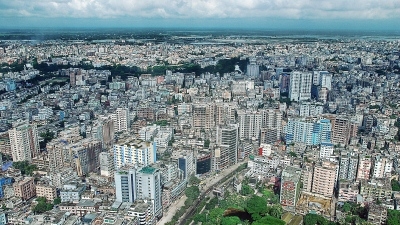Bangladesh aspires to attain middle-income status by 2021, the 50th anniversary of its independence. To do so, Bangladesh will need to accelerate growth and undergo a structural transformation that will change the geography of its economic production.
Critical to this transformation will be the creation of a competitive urban space – a space that has the capacity to innovate, is well connected internally and to external markets, and is livable. This is one of the insights emerging from the book, Bangladesh: The Path to Middle-income Status from an Urban Perspective, which was launched in Dhaka on June 15.
The book, published by the World Bank with support from Australian Aid and Cities Alliance, presents new empirical evidence on the drivers of and constraints to urban competitiveness through the lens of the private sector. The evidence is based on the results of a survey of 1,000 garment firms conducted across urban locations in Bangladesh.
“Strong economic growth has sustained and fueled urbanization in Bangladesh. And urbanization has enhanced economic transformation through the clustering of economic activities,” said Johannes Zutt, Country Director for Bangladesh and Nepal.
The book finds that Bangladesh’s rapid urbanization presents unique features which have implications for its journey to middle income status. Bangladesh has exceptionally high population density, and needs equally high economic density – which only highly competitive urban areas can sustain – to reach middle-income status.
The urban transition however, is not yielding all of its potential economic benefits. Bangladesh’s cities have extremely poor infrastructure and low level of services. Further, the high specialization of Bangladesh’s largest cities in low-value added, labor-intensive garment production is a constraint for growth.
Dhaka City
Bangladesh needs a vibrant, livable and economically diverse Dhaka City to reach middle-income status. Dhaka City has a productivity advantage among urban locations because of its unrivaled access to labor and markets. However, it is falling behind in accessibility and livability because of high congestion and severe constraints in land and housing markets. It needs to gain a competitive edge in higher-value-added products and services, as garment production de-concentrates to rapidly growing peri-urban areas.
Peri-urban metropolitan Dhaka
The peri-urban areas of metropolitan Dhaka are rapidly emerging as competitive manufacturing centers. However, they have not been able to develop to their full potential because their infrastructure requirements have gone largely unmet. These areas also indirectly suffer from the costs of traffic congestion in Dhaka City. To transform the peri-urban areas of Dhaka into globally competitive manufacturing centers, Bangladesh will require institutional mechanisms to support coordination between the core and the periphery of metropolitan Dhaka.
Chittagong City
The country’s largest seaport and second largest city, Chittagong City is a growing industrial center. From the perspective of garment firms, it is a lower-cost, lower-productivity location compared to Dhaka City. It is a less competitive location than Dhaka City in access to labor and market. But lower productivity compensates for lower land and housing costs. Chittagong City also has an advantage in accessibility given its access to the port.
“Chittagong City has failed to capitalize on its natural comparative advantage as Bangladesh’s largest seaport city. Improving the competitiveness of Chittagong Port as part of a modern logistic chain within the Dhaka-Chittagong corridor will be critical for growth,” said Ming Zhang, Sector Manager for the South Asia Urban & Water Unit.
Small and medium-size cities
Small and medium-size cities are uncompetitive locations that lack access to markets from the perspective of the garment sector. “Small and medium-size cities need to find their comparative advantages by relying on local entrepreneurship rather than attempting to attract firms from elsewhere through relocation incentives,” said Elisa Muzzini, Senior Economist, South Asia Urban & Water Unit.
The World Bank is supporting research and dialogue in Bangladesh on urbanization with different academic and research institutes in the country. The recent establishment of Bangladesh Urban Research Institute (BURI) in December 2012 has been an important step in fostering dialogue on this important agenda.

